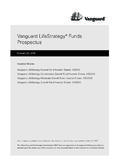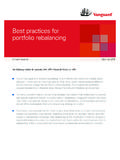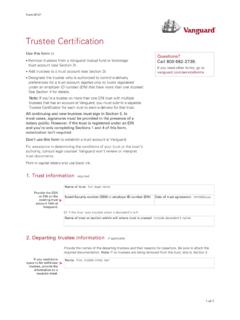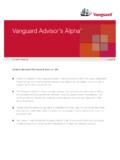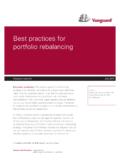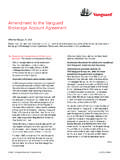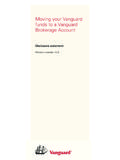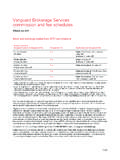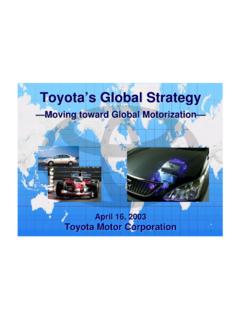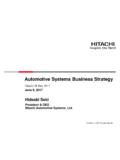Transcription of Building a global core-satellite portfolio - Vanguard
1 Vanguard research October 2010 Building a global core - satellite portfolio AuthorsDaniel W. WallickNeeraj BhatiaC. William ColeExecutive summary. The core - satellite approach to portfolio construction is a methodology used to combine actively managed funds with index funds in a single portfolio . The appeal of this approach is that it seeks to establish a risk-controlled portfolio while also securing some prospects of outperformance. The conventional view of the core - satellite methodology suggests it is prudent to use index funds for markets that are deemed efficient and to use active managers in areas considered to be inefficient, where the managers are presumed more likely to succeed. At Vanguard , we hold an alternative view of the core - satellite approach to portfolio construction. We conclude that indexing is a powerful strategy in all segments of the market, and that the active/index decision should therefore be predicated on an investor s ability to identify low-cost, talented managers, and not on the indiscriminate selection of active managers in market areas perceived to be with Vanguard > > ( investors)2 This paper reviews Vanguard s interpretation of the core - satellite methodology and summarizes original analysis we conducted to quantify a reasonable active/index allocation for individuals with differing investing skill levels.
2 Our analysis, which evaluated the 20 years ended December 31, 2009, reached the following conclusions: Talent trumps location. An investor s skill level in identifying managers, not the fund s asset-class location, is the most crucial factor in constructing a core - satellite portfolio . The process is not about simply investing in active funds in inefficient markets but about identifying low-cost talented managers wherever they may be. Indexing is valuable for all investors. Regardless of an investor s skill level, indexing is a valuable starting point for all portfolios. In fact, over the time period we examined, practically all investors in this study would have benefited from having a majority of their portfolio in a market index. This reflects the significant interrelationship between risk and return. Investors should expect to be compensated for taking market risk; therefore, it is not only the level of return that matters, but, more important, the level of return per unit of risk.
3 Similar results apply globally. These conclusions hold true across all equity markets examined in this study the United States, the United Kingdom, and on risk: All investments are subject to risk. Past performance is no guarantee of future returns. The performance of an index is not an exact representation of any particular investment, as you cannot invest directly in an index. Diversification does not ensure a profit or protect against a loss in a declining market. Foreign investing involves additional risks, including currency fluctuations and political uncertainty. Stocks of companies in emerging markets are generally more risky than stocks of companies in developed countries. Prices of mid- and small-cap stocks often fluctuate more than those of large-company returns will fluctuate. Investments in bond funds and ETFs are subject to interest rate, credit, and inflation risk. ETF shares can be bought and sold only through a broker (who will charge a commission) and cannot be redeemed with the issuing fund.
4 The market price of ETF shares may be more or less than net asset key termsAlpha. A portfolio s risk-adjusted excess return versus its effective A measure of the volatility of a security or a portfolio relative to a methodologyThe conventional viewConventional wisdom often suggests that indexing works best in the most efficient segments of the market and that active management works best in the inefficient market segments. Such an approach assumes that in the most efficient markets, information is readily available, thus allowing securities to be effectively priced by all market participants in quick order and offering little opportunity to outperform. On the other hand, it is further assumed that, in inefficient markets, information is less readily available and that, as a result, greater opportunities exist for individual managers to outperform their market benchmarks. This leads many practitioners to conclude that the relatively more efficient large-capitalization portion of their portfolios should be indexed while the less efficient market areas, such as small-cap or emerging markets, are better served with active strategies.
5 (See Figure 1.)1 For a more complete discussion of the zero-sum game, refer to Philips (2010a), for the market; and Marshall, Bhatia, and Wallick (2010), for the Australian market. 3An alternative viewVanguard subscribes to an alternative view of the core - satellite framework. We hold that the active/index decision should be based on an investor s ability to identify low-cost, expert managers, rather than on the location of a specific market segment. We conclude that although indexing has historically outperformed active management in aggregate over the long run, there may be some active managers who will outperform in all market segments. And although the dispersion in performance among managers within different market segments can vary widely, overall the zero-sum construct (see the description following) holds in each. (See Figure 2.) Talented managers, at a reasonable cost, regardless of the market segment, are by definition more likely to add value to a portfolio than other active managers selected indiscriminately from a presumably inefficient foundation of zero-sum investing is powerful.
6 The concept of the zero-sum game begins with the assertion that at any point in time, the holdings in a particular market aggregate to form the market. Since all invested dollars are represented in these holdings, every dollar that outperforms the market has to be accompanied by a dollar that underperforms the market, to collectively form the market return (Sharpe, 1991). This, of course, assumes there are no fees and expenses. When expenses are accounted for, less than half of the market s invested dollars can outperform the market. The zero-sum concept has merit in all view of core - satellite portfolio construction based on degree of market efficiencyAlternative view of core - satellite portfolio construction based on manager skill levelFigure large-capEx large-capCoreBeta exposure to broad small-capSatelliteEx small-capSatelliteEmerging marketsSatelliteAlpha strategies from successful managersSatelliteAlpha strategies from successful managersSatelliteAlpha strategies from successful managersSource: : Our research on the performance of mutual fund managers (a subset of all investors) is reflective of the zero-sum rule, even though zero-sum need not apply among a subset of the investors in a market.
7 We found that, over the long run, index investing has outperformed a majority of actively managed funds in markets considered inefficient. Among emerging market equity funds domiciled in the United States, we found that of the 121 funds in existence as of December 31, 1994, only 33%, or 40 funds, survived and outperformed the index over the subsequent 15 years. A total of 67%, or 81 funds, either underperformed the benchmark or failed to survive the 15 years. These findings are illustrated in Figure 3. Active emerging market fund performance relative to MSCI Emerging Markets IndexAnnualized excess returns, 1995 2009 Figure 3. 74% Did not opt out 18% Partial opt-out 8% Full opt-out1-year excess returns: Europe1-year excess returns: excess returns: Global10-year excess returns: Europe10-year excess returns: excess returns: Global01020304050 Dead fundsBetween 4% and 3%Between 3% and 2%Between 2% and 1%Between 1% and 0%Between 0% and 1%Between 1% and 2%Between 3% and 4%Between 2% and 3%Number of fundsExcess returns15-year: 81 underperformed (67%)15-year: 40 outperformed (33%)Notes: To calculate the impact of survivor bias, all share classes were counted.
8 All returns are for the 15 year period ended December 31, 2009. Dead funds are presumed to have underperformed; however, the extent to which they underperformed is unknown. Sample included 121 funds, all domiciled in the United States. domiciled funds were used due to an inadequate sample of UK domiciled funds that had targeted Emerging Market : Vanguard calculations, using data from Morningstar, Inc., and MSCI. MSCI Emerging Markets IndexThe findings were similar for small-capitalization funds; of the 236 funds that began the period, 75 funds (32%) survived and outperformed their benchmark over the subsequent 20 years ended December 31, 2009. A total of 161 funds (68%) failed to outperform their benchmark or survive the entire Again, our analysis concluded that most active managers will fail to outperform their respective benchmarks even in areas traditionally considered To calculate the impact of survivor bias, all share classes were counted.
9 All returns (annualized) are for the 20 years ended December 31, 2009. The sample included 236 funds. Dead funds are presumed to have underperformed; however, the extent to which they underperformed is unknown. Equity indexes were represented by the following indexes: Small-cap blend: S&P SmallCap 600 Index, December 31, 1989, through November 2002 and MSCI US Small Cap 1750 Index thereafter; Small-cap value: S&P SmallCap 600 Value Index, December 31, 1989, through November 2002 and MSCI US Small Cap 1750 Value Index thereafter; Small-cap growth: S&P SmallCap 600 Growth Index, December 31, 1989, through November 2002 and MSCI US Small Cap 1750 Growth Index thereafter. (Sources: Vanguard calculations, using data from Morningstar, Inc., MSCI, and Standard & Poor s.) 5 Despite these calculations, the perception of inefficient markets lingers for many investors. To some extent, this may be the residual impact of ineffective benchmarking. In the past, the way in which certain benchmarks were constructed seems to have contributed to the appearance of consistent outperformance in a few market segments, most notably among small-cap equities.
10 However, Davis, Kinniry, and Sheay s 2007 analysis effectively put an end to these misperceptions by pointing out that when the proper benchmark is considered, the perception of outperformance falls away is the right active/index mix in a portfolio ?How can an investor reconcile a desire to prudently include active management in his or her portfolio with evidence suggesting that a majority of managers will underperform, and that those who do succeed will not do so with a high degree of consistency? Or, in other words, what is the right mix of active and index funds in a portfolio ? To answer this question, we conducted a four-step optimization exercise (see Figure 4, on page 7), reviewing fund performance in the United States, the United Kingdom, and For each of these markets, we filtered 3 Using Morningstar mutual fund data, we reviewed the longest possible history for a meaningful quantity of funds. For the United States, this resulted in a 20-year time frame, while for the United Kingdom and Australia, the result was a 10-year time data using an ex post facto assessment of investors skill levels neutral, partial, perfect, or perfect but unlucky.
